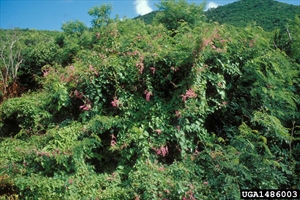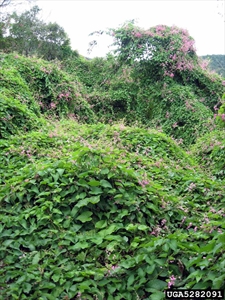Coral creeper. It is also known as coral vine, chain of love, Mexican creeper, corallita, and others.
Pacific Pests, Pathogens, Weeds & Pesticides - Online edition
Pacific Pests, Pathogens, Weeds & Pesticides
Coral creeper (502)
Antigonon leptopus. It is a member of the Polygonaceae.
Asia, Africa, North, South and Central America, the Caribbean, Europe (Portugal), Oceania. It is recorded from Australia, American Samoa, Cook Islands, Federated States of Micronesia, Fiji, French Polynesia, Guam, Kiribati, Marshall Islands, Nauru, New Caledonia, Niue, Northern Mariana Islands, Palau, Papua New Guinea, Pitcairn, Samoa, Solomon Islands, and Tonga. A native of Mexico.
A fast-growing vine occurring in a wide range of habitats, but preferring dry to moist lowland limestone soils. Often introduced as an ornamental for its showy flowers, and then escapes cultivation. Natural plant communities are destroyed as it smothers and kills trees, shrubs and understory plants, increasing the amount of litter on the ground and creating fuel for fires (Photos 1&2). It is adapted to disturbed areas, roadsides, wastelands, swamps, along riverbanks, dry coral cliffs, coastal and dry lowland forests. Rapid growth, ability to grow in different environments, large seed production (with long viability), presence of tubers, and an ability to regrow from stem pieces, combine to make this invasive weed difficult to control. Grows from sea level to 1000 masl.
Stems, woody, 5-12 m long, hairs variable (absent, sparse or abundant), angular to five-sided in cross-section. Leaves, alternately along the stems, triangular, oval or heart-shaped, lower leaves larger, on reddish stalks, 1-5 cm long (Photo 3). Flower clusters form at the end of branches or from the axils of leaves, 10-20 cm long, ending in long thin spiral stems (tendrils) that assist climbing (Photo 4). Individual flowers, pink (sometimes white), five 'petals', stalks hairy, 3-4 mm. Fruits, 3-sided, 5-8 mm long, hidden within remains of dead petals (Photo 5). Roots produce tubers.
Over short distances by trailing vines, and by broken pieces of stem carried by humans, wild animals, livestock and vehicles, regrowing rapidly at the nodes when in contact with soil. Seed may be eaten by birds and pigs. Over long distances tubers are spread in the movement of soil, seeds float on water and, most importantly, plants are moved locally and internationally with the trade in ornamental plants.
The smothering effects of coral creeper can be extremely damaging, impacting negatively on biodiversity. It is able to completrly destroy native plant communities. Areas of Guam and Hawaii have been the most impacted of the Pacific islands. On Christmas Island, it is reported to hinder migrating crabs.
Introduced widely as an ornamental plant in tropical climates around the world. A nectar source for honey. Teas are prepared from vegetative parts for colds. Seeds are eaten after toasting.
AUTHOR Grahame Jackson
Information from PIER (2017) Antigonon leptopus Hook.&Arn., Polygonaceae. Pacific Island Ecosystems at Risk (PIER), Institute of Pacific Islands Forestry. (http://www.hear.org/pier/species/senecio_madagascariensis.htm); and CABI (2019) Antigonon leptopus (coral vine). Invasive Species Compendium. (https://www.cabi.org/isc/datasheet/112316); and Antigonon leptopus Hook. & Arn. (2016) Weeds of Australia, Biosecurity Queensland Edition. Queensland Government. (https://keyserver.lucidcentral.org/weeds/data/media/Html/antigonon_leptopus.htm); and from Burke JM, DiTommaso A (2011) Corallita (Antigonon leptopus): Intentional introduction of a plant with documented invasive capability. Invasive Plant Science and Management 4:265-273 (BioOne) (https://bioone.org/journals/invasive-plant-science-and-management/volume-4/issue-3/IPSM-D-10-00088.1/Corallita-span-classgenus-speciesAntigonon-leptopus-span--Intentional-Introduction-of/10.1614/IPSM-D-10-00088.1.full#:~:text=Corallita%20(Antigonon%20leptopus)%3A%20Intentional,Plant%20with%20Documented%20Invasive%20Capability&text=Corallita%20(Antigonon%20leptopus)%20is%20a,ability%20to%20smother%20unsightly%20landscapes. Photos 1&2 Dan Clark, USDI National Park Service, Bugwood.org. Photo 3 Rebekah D. Wallace, University of Georgia, Bugwood.org. Photo 4 Patricia M. Ciesla, Forest Health Management International, Bugwood.org. Photo 5 William M. Ciesla, Forest Health Management International, Bugwood.org.
Produced with support from the Australian Centre for International Agricultural Research under project HORT/2016/185: Responding to emerging pest and disease threats to horticulture in the Pacific islands, implemented by the University of Queensland and the Secretariat of the Pacific Community.








